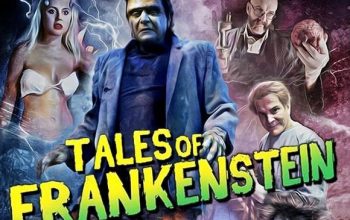Frankenstein Conquers the World – 1965

The scene: Toho Studios, 1964
Producer: We need a new monster movie. What have you got? Giant bee? Giant crab? Giant bee-crab hybrid?
Writer: I think we should look outside the box a little. We’re having some success selling our monster movies in America, so I have an idea to adapt a monster from Western lore – Frankenstein’s Monster!
Producer: How big is this monster?
Writer: Seven feet.
Producer: Pass.
Writer: I mean seven-ty feet?
Producer: …I’m listening.
This one’s a strange one. In WWII, the Nazis steal a trunk from a mad scientist. A German sub takes it to the Pacific and hands it over to a Japanese sub before being destroyed by Allied bombers. The Japanese sub commander hands it to a Japanese mad scientist, who opens it, revealing the heart of the Frankenstein Monster. This heart could hold the key to a huge range of medical advances. The Japanese scientist is about to operate on someone, when his hospital (and entire city) is blown up by the atomic bomb.
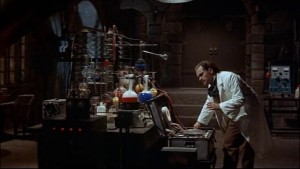
Fifteen years later, James Bowen (Nick Adams), an American doctor is working in Hiroshima hospital, treating surprisingly healthy looking radiation victims. He is very nice, and considers the bomb ‘tragic’, but also sees the aftermath as a scientific opportunity that could bring happiness out of tragedy. Looks very much like an attempt to frame the bombing in a way that is palatable to both American and Japanese audiences—no easy task today, and it must have been harder when the event was relatively recent. We later find out that the doctor was involved in some way with the Manhattan Project, and this is why he works with radiation victims.

Bowen’s colleague Dr Sueko narrowly misses an encounter with a mysterious figure who killed a dog to eat it. The next morning, schoolchildren find a mutilated rabbit in their classroom. Sueko and the doctor see a strange young man (Koji Furuhata) who gets hit by a car, but survives uninjured.
Later a mob corners the boy in a cave. As hospital staff, the doctors are allowed in alone to talk him out. (Japanese mobs are far more polite and considerate than their Viserian counterparts, I guess). Bowen establishes that the boy has been exposed to radiation but has no ill effects and wants to find out more about him.
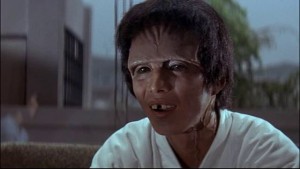
Meanwhile on an oil-rig, the former submarine commander is now in civilian life. He wonders idly about a connection between the radiation-proof boy and the heart he saw that wouldn’t stop beating. Then the oil-rig starts to shake, and collapses into the ocean moments after everyone evacuates. Kaiju attack! Yeah! Took twenty minutes to happen, but here it is! Drink it in, a giant monster…
Oh. It’s just Baragon. Sigh…
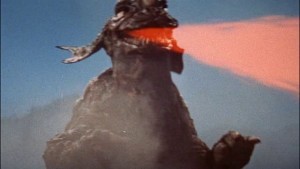
There’s some faffing about with Bowen, Sueko and the boy. Upshot is, the boy keeps growing, and Sueko can calm his rages. The sub commander turns up to tell the doctor his story. Another doctor, Kawaji (Tadeo Takashimi) goes to see the old mad scientist in Germany, who claims that Frankenstein (ie, the Monster) has been destroyed many times, but his heart always survives because protein cells and whatnot. He recommends checking if the boy is the Frankenstein Monster by amputating a limb and seeing if it grows back.
As a wise woman once said, ‘This is why a regular scientist is better than a mad scientist.’
After an inconclusive discussion about whether to amputate, Kawaji goes to amputate, but he’s interrupted by the arrival of a film crew. They set up lights and the Monster goes all King Kong and escapes.
Good. I think I’m getting to the point of the synopsis where I can just say ‘the Monster Rampages’, and that covers twenty minutes of the film.
Bowan and the army go to try to stop the Monster, to no avail. He gets away and goes to Sueko’s flat. For a moment, it looks like he’s going to kidnap her, but instead he walks away.
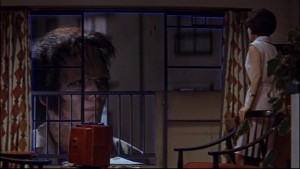
Some reporters investigating the escape wonder how the Monster slipped out of his chains. They discover the Monster’s still moving hand – presumably he broke his own hand off and escaped Deadpool style. He manages to remain at large, seemingly because he’s more intelligent and agile than most giant monsters. Lots of faffing about… come on, get to the Kaiju fight. Debate about whether to kill the Monster… Seems a moot point if they can’t find him.
There a lot of scenes here that kill time but fail to advance the plot. A dance club is attacked by Baragon! More faffing about… Baragon is a burrowing monster who arrives unseen, so people don’t know it’s him causing the damage, not the Monster. The Monster is found in a mine system… The army engages, the Monster shrugs off the bullets and chases off the army.
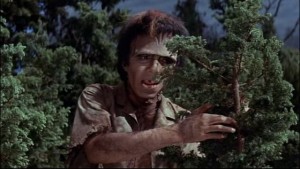
The doctors figure out that the mass destruction is caused by Baragon not the Monster, so the Monster needn’t be destroyed. There’s a lovely bizarre theory about dinosaurs surviving by learning to burrow and becoming luminous. Twenty minutes left and still no rampage. The doctors are running out of money for their helicopter flights. Uh… You know, I guess someone has to pay for them. They head out on foot looking for the Monster. They wander around a studio forest seemingly forever.
Kawaji decides that he wants to kill the Monster in a way that won’t damage his heart and brain, so those can still be experimented on. Unfortunately, his demonstration of his weapons attracts Barragon. Fifteen minutes of screen time left. Finally a rampage!
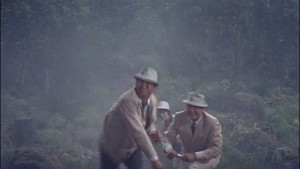
The Monster and Barragon tussle for a wile. Kawaji gets knocked out in the fight, and the Monster picks up his unconscious body and returns it to Bowen and Sueko, who are escaping in a car.
Baragon attacks a nearby village. The Monster turns up and fights him. Barragon starts a forest fire with his laser nose and the Monster fights him in the burning forest. He wins, but the dying Baragon creates a rift in the Earth, dragging both of them to their doom. The scientists believe that his heart will survive. The end.
The strange thing about this movie is… well, just about everything. Let’s break it up into specific stangenesses.
Firstly, I like the relationship between the doctor and Sueko. They’re co-workers who respect each other and are good friends. I thought the scene early on where they were having dinner at Sueko’s flat might be meant to be the start of a love story, but no. There’s no hint of a relationship between them and they work together towards a common goal. I’d really like to see more movies in which the male and female leads can work together productively in this way. It’s kind of refreshing.
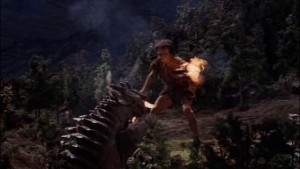
Secondly, look at just how agile the Monster is. The original version of the Monster from the novel is also portrayed a agile, but most film versions have portrayed the Monster as slow, lurching, awkward. This becomes even more apparent when the Monster is set against the Wolfman or Dracula – the Frankenstein Monster is the big, slow bruiser of the pairing.
But this is a kaiju movie. Compared to Godzilla, Gamera or Mothra, the situation reverses. The Frankenstein Monster is the lithe, agile fighter and the kaiju is the slow heavyweight. On the flip side, it makes the fakey looking Barragon even more fakey looking when he is in the same shot with what is clearly a normal guy.
Like so many kaiju films of this period, Frankenstein Conquers the World takes a very hard line against atomic weapons. Usually, though, this hard line is in the form of a metaphor. The original Godzilla movie both made the kaiju an atomic horror, and also wondered about the morality of using WMDs even in self-defense. It’s an interesting and a deep take, though the depth doesn’t always survive into the sequels.
This movie takes a somewhat less defensible line, portraying the reborn monster as something basically wonderful coming out of Japan’s WWII alliance with Germany, which is doomed by the bombing of Hiroshima. It’s probably not intended that way, but it’s hard to come up with a different interpretation.
Then there’s the movie’s takes an interesting view of the Monster’s humanity. The film portrays the Monster on one hand as a medical marvel who must be preserved for the sake of science. On the other hand, he’s presented as a tragic being who seeks some sort of connection with humanity and is unable to make one. The scene where he Godzillas his way up to a party boat but is driven away by the teenagers’ screams is almost poignant – but only almost.

Finally, there’s a little oddity in that the actor playing the Frankenstein Monster is clearly Japanese, but all the doctors keep insisting that he appears Causcasian. I don’t really have comment to make on that, other than what the hell?
Frankenstein Conquers the World is not a great movie. There’s not quite enough pathos for it to be a good Frankenstein movie, and not enough city-stomping for it to be a good kaiju movie. I suppose the inspiration for it was King Kong vs Godzilla, in which Toho’s greatest creation squared off against a favorite American movie monster. The problems with that are that firstly, Kong was an appropriate adversary for a kaiju and secondly, that King Kong vs Godzilla sucked anyway. Replacing Kong with Frankenstein’s Monster and Godzilla with Baragon took away from this decidedly second rate movie, rather than adding to it.
All in a unique and interesting take on the Frankenstein myth — with the proviso that the phrase ‘unique and interesting’ doesn’t necessarily mean ‘good.’



